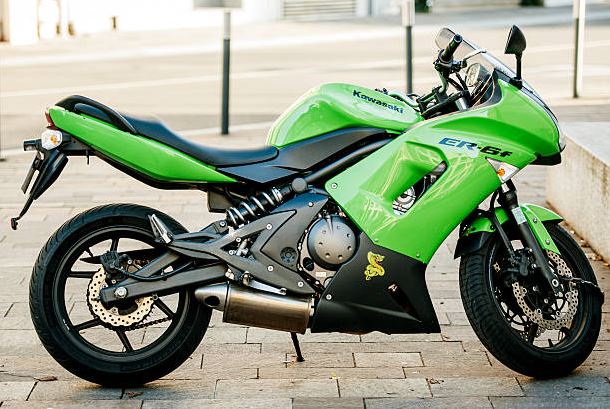The correct tire pressure for the front and rear tires of your Kawasaki KLR 650 bike will depend on the load, terrain, distance, and choice of tire. However, it is best to go with the factory recommendation, which is 21 psi for the front and 21-28 psi for the rear tires.
Kawasaki also outlined the different load capacities and their respective recommended psi value, as shown in the image of a page from the manual below:
However, when you take your motorcycle to a trusted dealer, they’d likely inflate your tires a few pounds above these factory-recommended psi values. There’s a reason for that.
In this article, I will show you everything you need to know (and consider) before choosing which pressure to inflate your KLR 650 tires.
Table of Contents
Tire Pressure For Klr 650: Load
When inflating adventure motorcycles, the tire pressure is the lifeblood of your overall riding experience. If you’re driving in rocky off-road conditions, and the pressure in the front wheel is too low, it can lead to bent rims.
On the other hand, if it’s over-inflated, the tire becomes non-flexible, leading to poor grip on asphalt that wears the center line out of the rear tire.
Regarding striking a balance, we also need to discuss the rider’s weight. I recommend inflating the front and rear tires of your KLR650 tire pressure to 32 and 30 psi, respectively, for a 175 lb rider. Then, you can take out a little air depending on your intended speed or load on the bike.
This is a safe and reliable inflation level, regardless of the tire brand or type.
KLR 650 Tire Pressure- Terrain
The Terrain you are driving around, that is, the driving condition, will also influence the decision on what the proper tire pressure for your KLR 650 should be. Fortunately, this largely depends on the tire you use on your Kawasaki bike.
Here’s an illustration of the recommended psi value to inflate your tires according to various driving conditions.
| Recommended psi for KLR 650 | ||
| Terrain | Front tires | Rear tires |
| Street | 28 psi | 25 psi |
| Dirt | 12 psi | 15 psi |
| every day riding | 22 psi | 24 psi |
| Offroad only | 18 psi | 20 psi |
Note that these psi values are what I use for my KLR 650 bike. They give me the best driving experience, but it still falls within the confines of ‘roughly speaking’ since it ultimately depends on the tire you’re using.
But since these tire pressures worked for me, I firmly believe you’d thank yourself for sticking to these values according to the different driving conditions.
Tips On Inflating Klr 650 Tires
Keep the following in mind when inflating your Kawasaki bike tires:
- It is best to check your tire pressure with a reliable tire pressure gauge when the tires are cold. That is, before riding the motorcycle more than a mile.
- The tire pressure on the KLR 650 can change during ambient temperature and altitude. This means you should often check and adjust the pressure when riding on wide variations of temps and altitude
- Inflating your bike’s tires with air far above the recommended psi for a particular load capacity or driving condition can impair your overall riding comfort and compromise the contact patch of the tire with the road. On the other side of the spectrum, underinflated tires cause poor handling, rapid tire wear, and increased fuel consumption.
- You can find the correct pressure for your particular KLR 650 model in the operating manual of the motorcycle. Still, you can adjust the values to suit your current driving if you change the factory-recommended psi to drive off the highway. Remember to reset your tire pressure to the correct value before riding back on the street.
FAQs
What Psi Should My Motorcycle Tires Be?
The recommended tire pressure for street motorcycles is between 28 and 40 psi. However, the exact psi for your bike’s front and rear tires will depend on the model, load, and road conditions.
What Size Tires Go On A Klr 650?
For the KLR 650, the front tires are equipped with a small 1.60 x 21″ rim that installs a 90/90 x 21″ tire, while the rear tires have a 2.50 x 17″ rim that seats a small 130/80 x 17″ tire size.
Conclusion
The debate on the correct tire pressure for Kawasaki motorcycles may always continue because, like oil discussions, everyone has their preference and what works for them best.
But if it’s your first time using the bike, and you want to avoid taking the risk of experimenting, then it is best to use the factory recommended.
The Kawasaki KLR650 was produced from 1987 to 2018. The recommended tire pressure for the KLR650 will ultimately depend on the model year and the tire used.
Meanwhile, it is unsafe to go with the recommendation of the tire manufacturers because that is the max PSI. In contrast, Kawasaki lists the PSI that will give the most comfortable ride under “normal” circumstances.
The bottom line is that, whatever your motorcycle recommends as a factory, consider going with a lower psi (the mid-20s) when riding on dirt and a higher psi (low to mid-30s) when riding on pavement.
Remember, you get better fuel economy when you go on higher tire pressure. The tires will also disperse heat better, thereby promoting its longevity.

